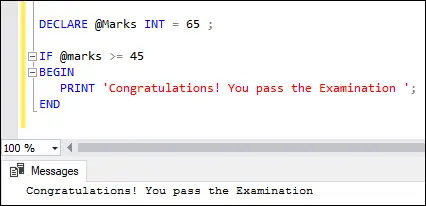Izjava IF je dio funkcije kontrolnog toka u SQL Serveru. Obično je to izjava o donošenju odluka u različitim programskim jezicima koja vraća vrijednost na temelju zadanih uvjeta . Ova naredba izvršava kod napisan u bloku IF kada se zadani uvjet procijeni kao istinito, a kada uvjet procijeni netočno, tada će se izvršiti naredba ELSE.
Izjava IF
Sljedeća je sintaksa koja ilustrira upotrebu ove izjave u SQL Serveru:
IF boolean_expression BEGIN { statement_block } END U gornjoj sintaksi, blok_izjava u POČETAK...KRAJ blok se izvršava kada je booleov_izraz je zadovoljan stanjem. U suprotnom, ovaj blok se preskače, a kontrola programa se premješta u naredbu nakon KRAJ ključna riječ. Trebali bismo znati da ako izraz sadrži a IZABERI izjavu, moramo zatvorite ih u zagrade .
Primjer
Pogledajmo primjer kako bismo razumjeli naredbu IF bez bloka ELSE. Primjer ispod će prikazati rezultat kada je uvjet zadovoljen. U suprotnom, kontrola programa premještena je na naredbu nakon ključne riječi END, ako postoji.
DECLARE @Marks INT = 65 ; IF @marks >= 45 BEGIN PRINT 'Congratulations! You pass the Examination'; END
Izvršenje izjave dat će donji izlaz:

Sada ćemo to demonstrirati na donjem ' Student' tablica sa sljedećim podacima:

Dolje je još jedan primjer koji dobiva ukupne ocjene odabranog studenta iz ' Student' tablicu u uzorku baze podataka i zatim ispisuje a poruka ako je veći od 400 .
BEGIN DECLARE @Total_Marks INT; SELECT @Total_Marks = total_marks FROM Student WHERE age>25; SELECT @Total_Marks; IF @Total_Marks > 400 BEGIN PRINT 'Congratulations! You pass the Examination'; END END
Dobit ćemo sljedeći izlaz:

Ako želimo vidjeti gornju izlaznu poruku, trebali bismo kliknuti Poruke kartica:

Izjava IF-ELSE
U scenariju stvarnog svijeta, moramo izvršiti neku radnju kad god je uvjet u naredbi IF TRUE ili FALSE. U ovom slučaju korisna je izjava IF…ELSE. Ova naredba izvršava blok naredbi ELSE kada je uvjet u klauzuli IF procijenjen kao FALSE.
Slijedi sintaksa koja ilustrira upotrebu naredbe IF ELSE u SQL Serveru :
IF expression BEGIN Statement block -- It executes when the IF clause expression is TRUE. END ELSE BEGIN Statement block -- It executes when the IF clause expression is FALSE. END
Primjer
Pogledajmo primjer kako bismo razumjeli naredbu IF s blokom ELSE. Donji primjer prikazat će poruku ' Čestitamo! Polažete ispit ' kada je IF uvjet zadovoljen. U suprotnom, prikaži ' Propali ste! Više sreće sljedeći put '.
DECLARE @Marks INT; SET @Marks = 65; IF @marks <45 begin print 'congratulations! you pass the examination'; end else 'you are failed! better luck next time'; < pre> <p>Executing the statement will give the below output. Here, the <strong>marks</strong> variable is <strong>65</strong> , and the <strong>condition (65<45)< strong> is not satisfied. Therefore, the message inside the ELSE block is displayed:</45)<></strong></p> <img src="//techcodeview.com/img/sql-server-tutorials/49/sql-server-if-else-5.webp" alt="SQL Server IF ELSE"> <p>We will get this output because the condition <strong>(65>45)</strong> is satisfied. Therefore, the message inside the IF block is displayed:</p> <img src="//techcodeview.com/img/sql-server-tutorials/49/sql-server-if-else-6.webp" alt="SQL Server IF ELSE"> <p>Now, we will demonstrate the IF ELSE statement on the above ' <strong>Student'</strong> table. In this example, we are going to check whether the student <strong>total marks</strong> is <strong>greater than or equal to 400</strong> or not as follows:</p> <ul> <li>When the IF condition is TRUE, we will get the student records whose total marks are greater than or equal to 550.</li> <li>If the condition is FALSE, we will get the student records whose total marks are less than 550.</li> </ul> <p>Here is the program:</p> <pre> DECLARE @Marks INT; SET @Marks = 600 ; IF @Marks >= 550 BEGIN SELECT id, name, gender, age, total_marks FROM Student WHERE total_marks >= 550 ORDER BY age ASC END ELSE BEGIN SELECT id, name, gender, age, total_marks FROM Student WHERE total_marks <550 order by age asc end < pre> <p>In this code, we have specified the <strong>@Marks</strong> variable to <strong>600</strong> , and the condition (600 >= 550) is satisfied. Therefore, we will get the output where student records whose total marks are greater than or equal to 550 are displayed.</p> <img src="//techcodeview.com/img/sql-server-tutorials/49/sql-server-if-else-7.webp" alt="SQL Server IF ELSE"> <p>If we changed the <strong>@Marks</strong> variable to <strong>500</strong> and the condition (500 >= 550) becomes false. Therefore, we will get the output where student records whose total marks are less than 550 are displayed.</p> <img src="//techcodeview.com/img/sql-server-tutorials/49/sql-server-if-else-8.webp" alt="SQL Server IF ELSE"> <h2>Nested IF ELSE Statement</h2> <p>Unlike other programming languages, we can nest an IF...ELSE statement inside another IF...ELSE statement in SQL Server. Let us demonstrate it with the following example:</p> <pre> DECLARE @age INT; SET @age = 6; IF @age <18 50 print 'you are underage'; else begin if @age < below 50'; senior cetizen'; end; pre> <p>In this example, we are going to check whether the <strong>age is underage, below 50, or senior citizen</strong> as follows:</p> <ul> <li>If the value of the <strong>@age</strong> variable is below <strong>18</strong> , it will print the person is <strong>underage</strong> .</li> <li>If the condition is FALSE, the ELSE part will be executed that has a nested IF…ELSE.</li> <li>If the value of the <strong>@age</strong> variable is under <strong>50</strong> , it will print <strong>below 50</strong> . Finally, if no condition is satisfied, it will print <strong>senior citizens</strong> .</li> </ul> <p>Here is the result:</p> <img src="//techcodeview.com/img/sql-server-tutorials/49/sql-server-if-else-9.webp" alt="SQL Server IF ELSE"> <p>This article gives a complete overview of how to use the SQL Server IF ELSE statement. Here we have learned:</p> <ul> <li>Variables are objects that serve as placeholders.</li> <li>The keyword BEGIN will be used to start a statement block, and the END keyword must be used to close it.</li> <li>The use of ELSE in an IF... ELSE statement is optional.</li> <li>It's also possible to nest an IF...ELSE statement inside another IF...ELSE statement. However, nesting an IF statement within another statement is bad practice because it makes the code difficult to read and maintain.</li> </ul> <hr></18></pre></550></pre></45>
